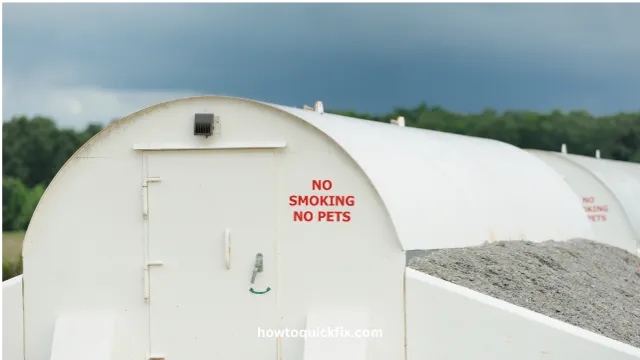A metal storm shelter is your ultimate refuge during natural disasters, offering safety and peace of mind in dire situations. However, over time, these enclosed spaces can become breeding grounds for germs, bacteria, and even mold. Maintaining a clean and disinfected storm shelter is not just about hygiene—it’s about safeguarding your health and ensuring it remains a truly secure space.
Think about it: after a storm, you might find your shelter filled with debris, moisture, or even unpleasant odors. Ignoring this can lead to unsanitary conditions, putting your family at risk when they rely on it most. Regular cleaning and disinfecting are crucial steps to ensure your shelter remains a safe haven.
In this blog, we’ll guide you through effective ways to clean and disinfect your metal storm shelter, using easy-to-find supplies and practical techniques. By the end, you’ll have all the knowledge you need to maintain your shelter and keep it ready for emergencies.

Contents
- 1 1. Why Disinfecting Your Storm Shelter is Important
- 2 2. Preparing to Clean Your Storm Shelter
- 3 3. Cleaning the Shelter’s Surface
- 4 4. Applying Disinfectants Safely
- 5 5. Maintaining a Clean Shelter
- 6 Conclusion
- 7 FAQs
- 7.1 How often should I disinfect my storm shelter?
- 7.2 What cleaning supplies are safe for metal storm shelters?
- 7.3 Can I prevent mold in my storm shelter?
- 7.4 What should I avoid when disinfecting a storm shelter?
- 7.5 Is it safe to use bleach in a storm shelter?
- 7.6 Can I use natural cleaners instead of commercial disinfectants?
1. Why Disinfecting Your Storm Shelter is Important
Disinfecting your storm shelter is more than just cleaning—it’s about protecting health and longevity.
Storm shelters can accumulate dirt, moisture, and organic matter, creating an ideal environment for mold and bacteria. If left unchecked, this can cause respiratory issues and infections for those who use the shelter.
Additionally, regular disinfecting helps to preserve the integrity of the metal, preventing rust and corrosion that may weaken the structure over time.
2. Preparing to Clean Your Storm Shelter
Before starting, gather all necessary supplies like gloves, masks, cleaning agents, and disinfectants. Ensure good ventilation by opening the shelter’s doors or vents.
Remove debris such as leaves, mud, or any leftover items from the last use. Sweep the floor thoroughly to create a clean surface for disinfecting.
Inspect the shelter for damage or leaks. Address these issues immediately to prevent water or bacteria from seeping into the structure.
3. Cleaning the Shelter’s Surface
Begin by washing all surfaces with a mixture of warm water and mild detergent to remove dirt and grime.
Use a scrub brush or sponge to clean walls, floors, and ceilings. Pay special attention to corners and seams where dirt can accumulate.
Rinse thoroughly with clean water to ensure no soap residue is left behind, as this can interfere with the effectiveness of disinfectants.
4. Applying Disinfectants Safely
Choose a disinfectant suitable for metal surfaces, such as bleach diluted with water or commercial metal-safe solutions.
Spray the disinfectant evenly across all surfaces, ensuring complete coverage. Let it sit for the recommended time to effectively kill germs.
Wipe the surfaces dry with a clean cloth to prevent moisture buildup, which can lead to rust or mildew in the future.
5. Maintaining a Clean Shelter
Regular maintenance is key to keeping your storm shelter disinfected and ready for use. Schedule a monthly cleaning routine, especially during storm seasons.
Install a dehumidifier or moisture absorber to prevent damp conditions that encourage bacterial growth. Keep the shelter stocked with cleaning supplies for quick touch-ups.
Avoid storing perishable or damp items inside the shelter, as they can introduce bacteria or odors. Always ensure the shelter remains dry and ventilated.
Conclusion
A clean and disinfected storm shelter is essential for ensuring both safety and health during emergencies. By following proper cleaning procedures and maintaining a regular routine, you can protect your family from unnecessary health risks while preserving the shelter’s durability.
Taking the time to disinfect your metal storm shelter is an investment in your safety. It ensures that when the next storm hits, your shelter will be a safe and sanitary refuge. With the right tools and approach, this process can be straightforward and highly effective.
Don’t wait for a storm to test your preparedness—start disinfecting your shelter today, and enjoy the peace of mind that comes with knowing your emergency space is truly ready.
FAQs
How often should I disinfect my storm shelter?
You should disinfect your storm shelter at least once a month or after each use during storm seasons.
What cleaning supplies are safe for metal storm shelters?
Use mild detergents, metal-safe disinfectants, and diluted bleach solutions to clean your storm shelter effectively.
Can I prevent mold in my storm shelter?
Yes, using a dehumidifier, proper ventilation, and regular cleaning can prevent mold and mildew from forming.
What should I avoid when disinfecting a storm shelter?
Avoid using harsh chemicals that can corrode metal or leave strong residues. Always dry the surfaces thoroughly to prevent rust.
Is it safe to use bleach in a storm shelter?
Yes, diluted bleach is safe for disinfecting, but ensure proper ventilation and avoid prolonged contact with metal surfaces.
Can I use natural cleaners instead of commercial disinfectants?
Yes, natural options like vinegar and baking soda can work but may not be as effective as commercial disinfectants for killing bacteria.








